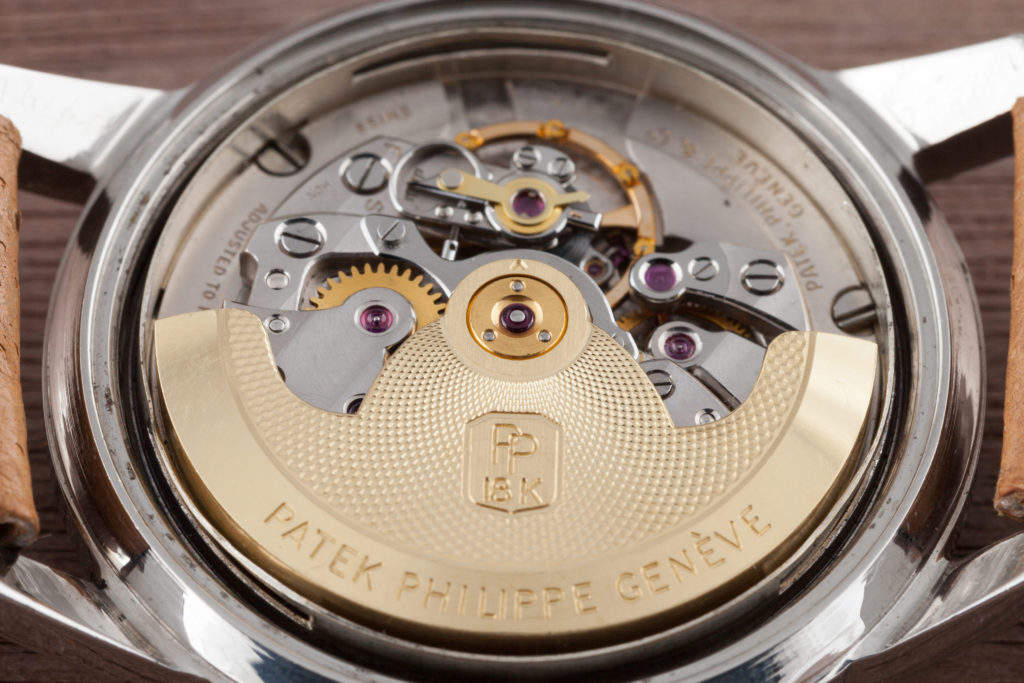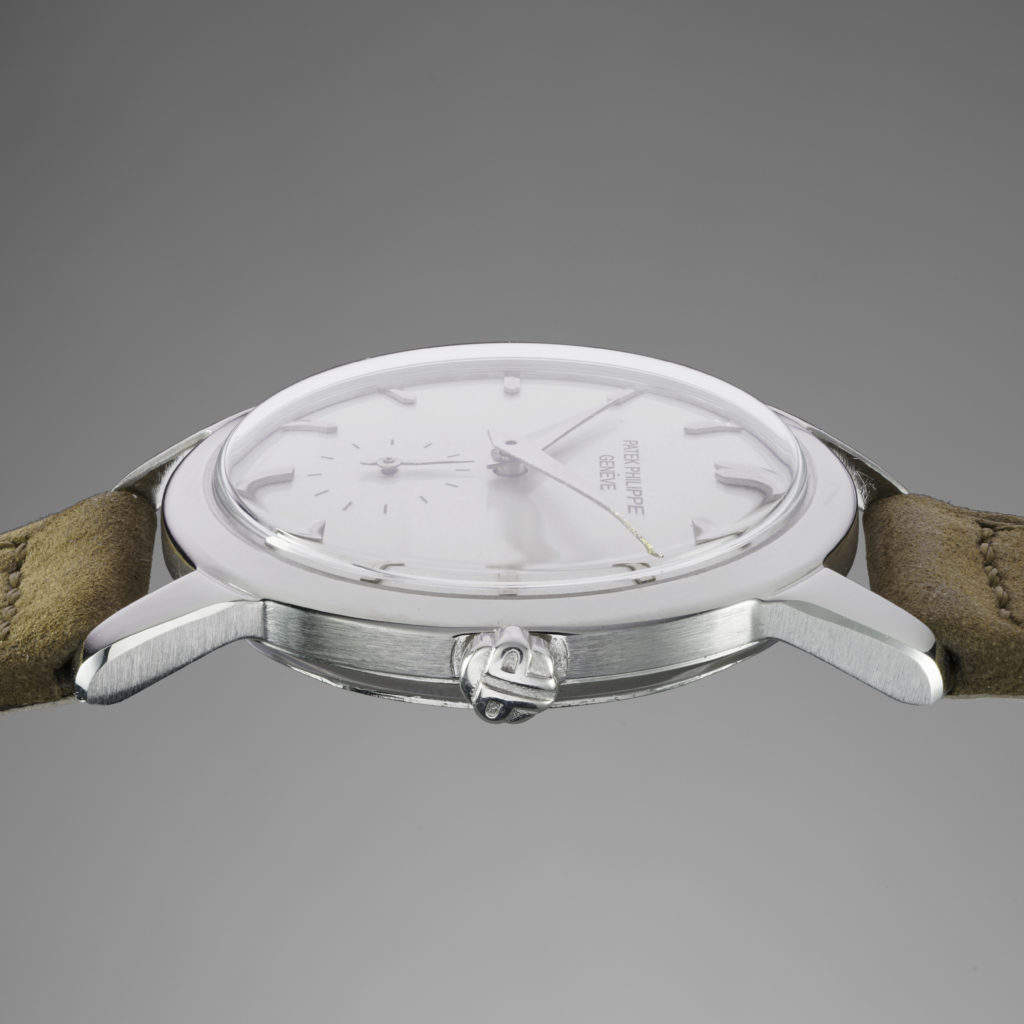Being a disciplined follower and sometimes buyer at auctions has many advantages.
One of the many advantages is that you get to study buying behaviour. Especially when two of the exact same watches come up for sale and one of the watches fetches almost 700% more than the other.
This is exactly what happened with the reference 2585 of Patek, a 1950s automatic steel watch.
One sold last November at Phillips for CHF 100’000. The other sold in 2015 for CHF 785’000 also at Phillips. Both are in steel. Same dial. Same design. Same movement. Same reference. Only 5 numbers apart in terms of case numbers. One made in 1958 and the other made in 1956. What could explain this massive price difference?
Let us investigate.
(Main picture a close-up of the dial of the trophy 2585 that fetched CHF 785k at Phillips in 2015). Credit: Phillips watches.
In 2015 when Phillips first sold the 2585 it was thought to be the only known reference 2585.
Made in 1958 and sold in 1960- this Patek was a very rare Calatrava made in steel. Fitted with the celebrated automatic movement (Patek’s first automatic movement) 12-600, with a screw back case – it was no surprise this watch was going to attract immense interest. Furthermore, this watch was seen as so important that it was featured in the the Goldberger book, Patek Steel watches. This watch had everything going for it. Rarity, beautiful movement, nice case size (35mm), beautiful winding crown and cased in steel. The watch was estimated at CHF 80-120’000 and ended up selling for CHF 785’000 after a bidding war between two buyers. Now CHF 785’000 for a time only watch is serious money.
Here is the watch below as it appeared in the Goldberger Patek steel book.


(Credit: Goldberger).
Fast forward to 2017 and Phillips discovers a second 2585. Made only 5 case numbers earlier than the sister watch sold in 2015, the watch is as you would expect identical in terms of case, movement, dial and production. The watch sells for CHF 100’000 against an estimate of CHF 50’000 – 100’000.
What on earth could account for the big difference in price between the two watches? Has the market demand for Patek changed that much since 2015?
The price difference between the two watches can be explained in one word: Condition.
While last year has belonged to Rolex in terms of collector interest and records (first the Bao Dai) and then the Paul Newman claiming incredible results, the reason the latest Patek 2585 sold for CHF 100’000 – versus CHF 685’000 for the sister watch two years ago, has nothing to do with Patek being less in demand than Rolex. It has to do with the fact that one watch was heavily restored and the other one was untouched.
The first 2585 Patek sold in 2015 by Phillips was the perfect example. Exceptional case, original dial, and clean movement. The second watch that sold this November in 2017 was everything the other watch was not. Dial cleaned and restored, case polished and restored. As the Phillips condition reports states:
The case has been professionally restored and as such is in overall superb condition with no signs of wear. The silver dial has been restored and shows no signs of ageing.
Let’s contrast this with the condition report Phillips put out for the 2015 Patek that sold for almost 7x more: The case is in very good condition, with strong definition to the bevel on the bezel and the lugs. The dial is absolutely original and unrestored with excellent hard enamel signature.
Those subtle differences in words: restored versus original and unrestored is what explains the massive price difference of both watches.
The market spoke in this case and allocated a hefty difference in terms of separating an original watch in superb condition and a watch that was restored. In this case, the price of originality was CHF 685’000 in additional value that the buyer thought was justified for quality in 2015.
Closing thoughts
What are my thoughts to the resulting price difference?
I have always believed in paying up for quality and believe that you can never pay enough for trophy assets. Did the buyer of 2585 this year get a good deal for paying only CHF 100’000? Or did the buyer of the watch in 2015 overpay in a bidding war?
These questions are tricky to answer as buying watches is not an exact science with a right formula. What I will say the following: If my budget allows, I will always prefer to be on the side of overpaying for a trophy asset as a collecting strategy.
Here are the pictures of both watches (all credit Phillips watches). The only two known (there are thought to be three in existence) Patek 2585.
We start off with the first and the better quality one that sold in 2015 by Phillips. Notice the hard raised enamel signature on the dial. Unrestored and untouched.

The second picture shows the case with integrated ‘qp’ winding crown. Notice the nice strong lugs.

Another view of the case design, an all steel Patek automatic wristwatch.

The celebrated and iconic movement 12-600 AP with gold rotor below, that for many is the most beautiful movement that Patek ever made.
Notice the perlage on the movement finely engraved, something Patek would discontinue with the upgraded movement the 24-700.
Another point to mention regarding the movement is what Phillips writes in their condition report concerning the movement: Hardly any signs of wear to bridges and screw–heads.

The last picture of the 2585 trophy watch from the front. The signature stands out strong and clearly, still raised and untouched. (Credit: Goldberger).

Let us move on to the second 2585 Patek that sold last November in 2017 also at Phillips for CHF 100’000. It is interesting to study two of the same references with different condition and states of originality.
The case is similar below but has been this time ‘professionally restored‘.

Notice the difference in signature between this watch below and the one above (better quality one). Especially the letter ‘A’ in Patek.

The last picture of the 2585 with same movement 12-600 AT.
The movement of the watch below looks less pristine than the other 2585 (but perhaps am influenced now by the numbers and condition reports read).

